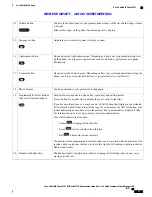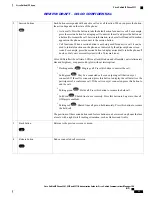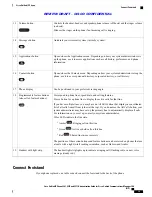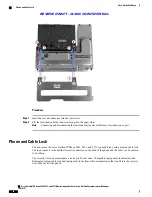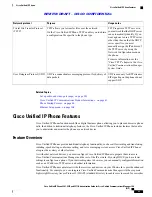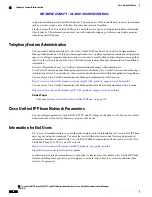
Usage notes
Purpose
Network protocol
TFTP requires a TFTP server in
your network that the DHCP server
can automatically identify. If you
want a phone to use a TFTP server
other than the one that the DHCP
server specifies, you must
manually assign the IP address of
the TFTP server by using the
Network Configuration menu on
the phone.
For more information, see the
“
Cisco TFTP
”
chapter in the
Cisco
Unified Communications Manager
System Guide
.
TFTP allows you to transfer files over the network.
On the Cisco Unified IP Phone, TFTP enables you to obtain
a configuration file specific to the phone type.
Trivial File Transfer Protocol
(TFTP)
UDP is used only for RTP streams.
SIP signaling on the phones do not
support UDP.
UDP is a connectionless messaging protocol for delivery of
data packets.
User Datagram Protocol (UDP)
Related Topics
Set up audio and video port range, on page 201
Cisco Unified IP Communications Product Interactions, on page 41
Phone Startup Process, on page 48
Ethernet Setup menu, on page 104
Cisco Unified IP Phone Features
Cisco Unified IP Phones function much like a digital business phone, allowing you to place and receive phone
calls. In addition to traditional telephony features, the Cisco Unified IP Phone includes features that enable
you to administer and monitor the phone as a network device.
Feature Overview
Cisco Unified IP Phones provide traditional telephony functionality, such as call forwarding and transferring,
redialing, speed dialing, conference calling, and voice messaging system access. Cisco Unified IP Phones
also provide a variety of other features.
As with other network devices, you must configure Cisco Unified IP Phones to prepare them to access
Cisco Unified Communications Manager and the rest of the IP network. By using DHCP, you have fewer
settings to configure on a phone. If your network requires it, however, you can manually configure information
such as: an IP address, TFTP server, and subnet information.
Cisco Unified IP Phones can interact with other services and devices on your IP network to provide enhanced
functionality. For example, you can integrate Cisco Unified Communications Manager with the corporate
Lightweight Directory Access Protocol 3 (LDAP3) standard directory to enable users to search for coworker
Cisco Unified IP Phone 8961, 9951, and 9971 Administration Guide for Cisco Unified Communications Manager 10.0
(SIP)
25
Cisco Unified IP Phone
Cisco Unified IP Phone Features
REVIEW DRAFT - CISCO CONFIDENTIAL



